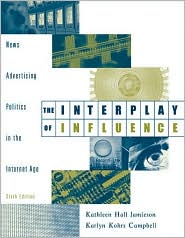11/25/2007
The Interplay of Influence
 I just had the honor of reading a book published in 1988 called The Interplay of Influence: Mass Media and Their Publics in News, Advertising, Politics by Kathleen Hall Jamieson. It is possible that a more updated version was meant to reach my eyes, but alas, it didn't. Nevertheless, my time-traveling exercise has given me some interesting perspective on today's issues of mass media manipulation in politics and advertising (and vice and versa). The bottom-line is that things are not dramatically different then they were in 1988. I know, we have blogs and YouTube debates in 2007. Now it's We, the Media, right? Unfortunately, no. The web and blogs, etc. contribute to the diversity of news, including forcing out stories that otherwise would be buried. The term "mass media" now has an entirely different meaning. But people still get news from the news. Regardless of what people ask in their YouTube debate question video, CNN is still the one deciding if it goes on the air. It is the CNN/YouTube debate, afterall. In this sense, the news is working in the same way it has worked since the advent of modern mass communication. Jamieson breaks down just what "news" really is:
I just had the honor of reading a book published in 1988 called The Interplay of Influence: Mass Media and Their Publics in News, Advertising, Politics by Kathleen Hall Jamieson. It is possible that a more updated version was meant to reach my eyes, but alas, it didn't. Nevertheless, my time-traveling exercise has given me some interesting perspective on today's issues of mass media manipulation in politics and advertising (and vice and versa). The bottom-line is that things are not dramatically different then they were in 1988. I know, we have blogs and YouTube debates in 2007. Now it's We, the Media, right? Unfortunately, no. The web and blogs, etc. contribute to the diversity of news, including forcing out stories that otherwise would be buried. The term "mass media" now has an entirely different meaning. But people still get news from the news. Regardless of what people ask in their YouTube debate question video, CNN is still the one deciding if it goes on the air. It is the CNN/YouTube debate, afterall. In this sense, the news is working in the same way it has worked since the advent of modern mass communication. Jamieson breaks down just what "news" really is:News is what reporters, editors, and producers decide is news. [It] is selected, even created by newspeople. It claims that news is not just 'the facts' but also rhetoric- messages influencing how readers and viewers perceive reality. News is gathered, written, edited, produced, and disseminated by human beings who are part of organizations and who have beliefs and values. Organizations, such as networks, have functions and goals as well as relationships to government, to regulatory agencies, to advertisers, and to the vast audiences they seek to attract. These beliefs, values, functions, and interests are bound to influence the messages these networks publish and broadcast.In this sense, news is no different now than it was in 1988. Cable news is all about rhetoric. They've got it down pat. Look at Fox News. Jamieson wonders if Fox is becoming "another network" in 1986. Yikes. Unfortunately, rhetoric-heavy, highly-corporate-influenced, government-connected news sources like Fox are still the source of "the news" for millions of Americans. PBS did an interesting study here. And corporate consolidation of networks continues. CNN, although not as bad as Fox, is still the perfect example of what Jamieson was describing above. Nevertheless, I commend them for the YouTube debates. Much like they was the first 24 hour news channel, CNN has broken new ground again by recognizing the democratic potential of video uploading websites. But imagine a YouTube debate without the "interplay of influence" of a large media network like CNN. Could it be possible? Time will tell.
Labels: CNN, Jamieson, News, The Interplay of Influence, YouTube
